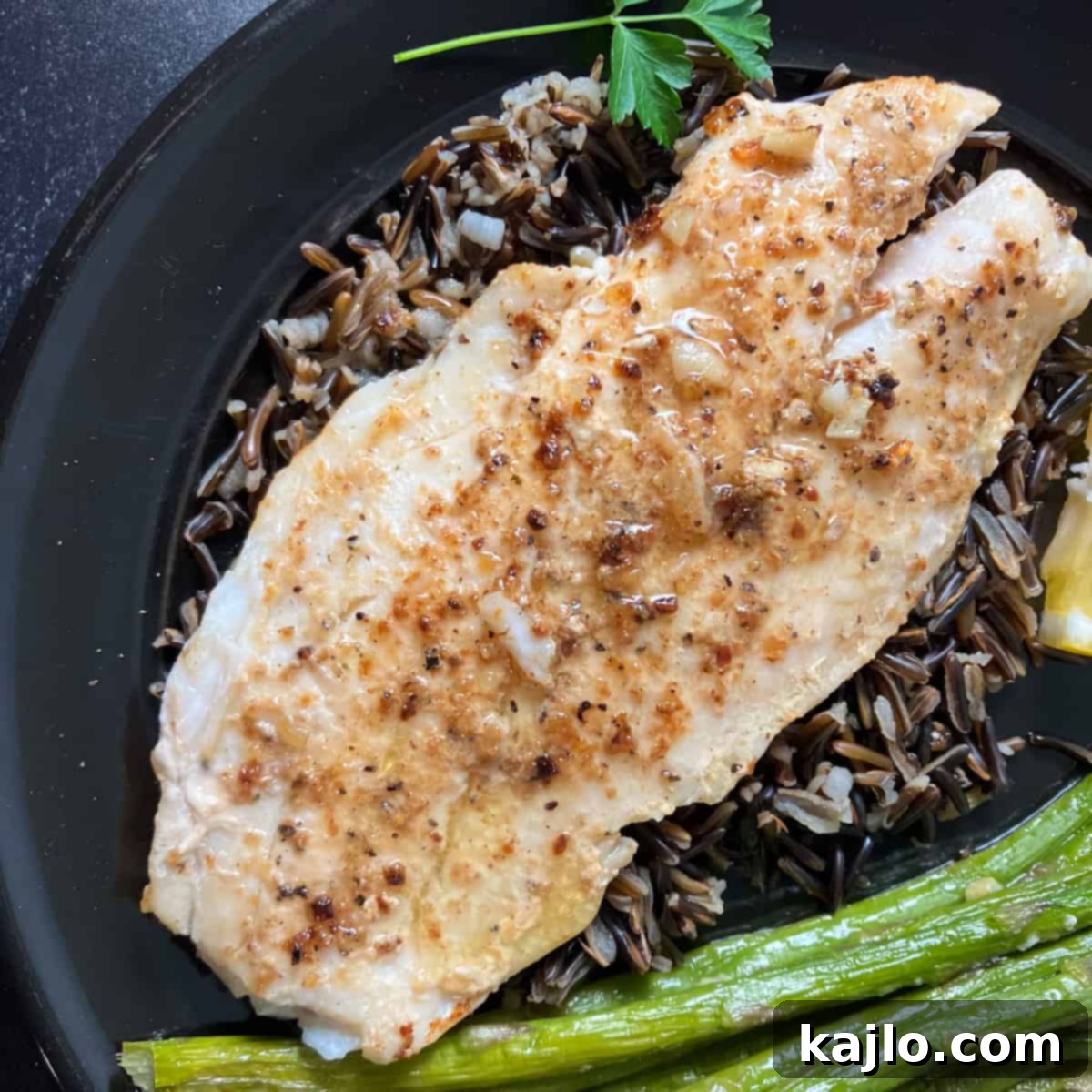The Ultimate Guide to Cooking Orange Roughy: Pan-Fried, Baked, Broiled & More
Are you searching for the best way to cook orange roughy? Look no further! This comprehensive guide explores three popular methods—pan-frying, baking, and broiling—to help you achieve perfectly cooked, delicious fish. I’ll share my top choice and delve into other convenient options like grilling and air frying. Get ready to transform your orange roughy fillet into a healthy and memorable dinner that might just become your new favorite!
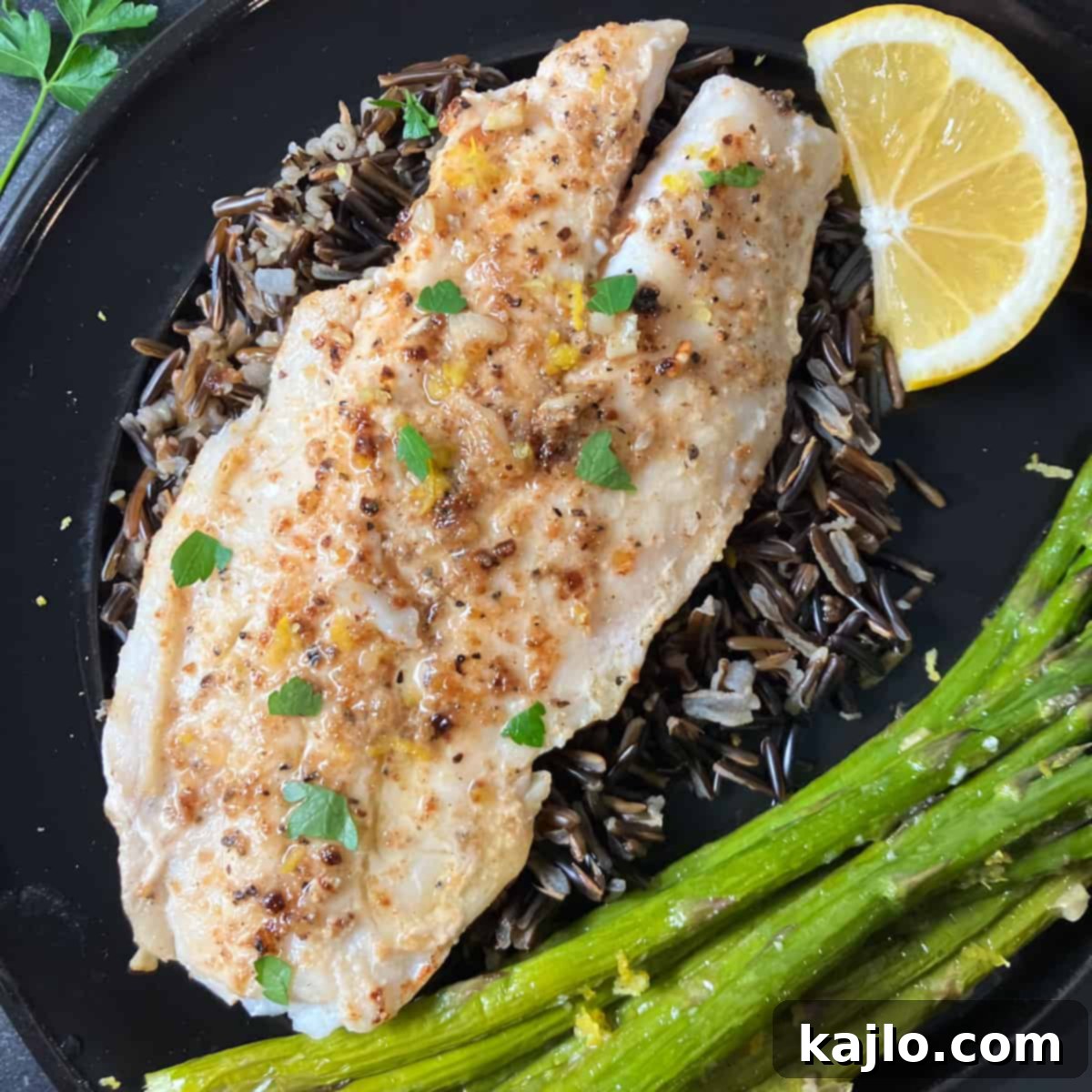
“Love it!” – Norma Jean
Orange roughy, also known by its less appealing names like slimehead or deep sea perch, is a remarkable low-fat whitefish that lends itself to a variety of culinary preparations. In this guide, we’ll season our orange roughy fillet with a classic lemon pepper blend and cook it with a touch of garlic butter. Sometimes, the simplest ingredients yield the most outstanding flavors, allowing the delicate taste of the fish to truly shine through.
You have the flexibility to prepare your orange roughy recipes baked in the oven, broiled for a crisp finish, or pan-fried in a skillet on your stovetop. For ultimate convenience, especially during warmer months when you want to keep your kitchen cool, you can even air fry orange roughy. The abundance of cooking options ensures that you can enjoy this versatile fish no matter your preference or the weather outside.
If orange roughy isn’t yet a staple in your seafood repertoire, now is an excellent time to introduce it. Many people find its flavor profile much milder and less “fishy” than popular choices like tuna or salmon. This subtle taste and delicate texture make orange roughy an ideal gateway fish for those who typically hesitate to try seafood, potentially converting even the most discerning palates.
🐟 Is Orange Roughy Good Eating? What Does it Taste Like?
In my humble opinion (IMVHO), orange roughy is indeed a very good eating fish. It offers a mild, clean flavor and a wonderfully delicate, flaky texture that is highly enjoyable. The taste is often compared to tilapia, making it a familiar and approachable option for those new to this specific whitefish. Its gentle flavor absorbs seasonings beautifully without being overpowering.
⭐ The Remarkable Benefits of Orange Roughy
Beyond its deliciousness, here are several compelling reasons to incorporate orange roughy into your meal plan:
- Effortlessly Simple to Cook: This is a remarkably easy fish recipe perfect for weeknights. Preparation involves minimal fuss; just season your fillets and cook. There’s no need for complicated steps like wrapping in foil or parchment paper. You can cook orange roughy directly in a skillet, baking dish, or under the broiler, simplifying your kitchen routine.
- Lean Protein, Low Calorie, and Low Fat: Orange roughy stands out as a lean protein source, naturally low in calories and fat. This makes it an excellent choice for individuals focused on weight loss or maintaining a healthy diet. It provides substantial protein to keep you feeling full and satisfied without a high caloric cost. However, because it’s a lean fish, it doesn’t offer the same high levels of beneficial Omega-3 fatty acids (EPA and DHA) as fattier fish like salmon or mackerel.
- Naturally Low Carb and Diet-Friendly: Being inherently low in carbohydrates, orange roughy is a perfect fit for keto, low-carb, and gluten-free dietary patterns. It’s also an ideal choice for pescatarians, easily integrating into various special diets without requiring complex substitutions or adjustments.
- Superbly Delicious and Versatile: When seasoned thoughtfully and cooked correctly, orange roughy fillets offer a delightful taste and texture. Their delicate flavor serves as a versatile canvas, making them a tasty entrée suitable for a wide range of family dinners. Its mild profile pairs well with numerous side dishes and flavor combinations, ensuring it never gets boring.
⚠ Important Considerations: Why Orange Roughy Should Sometimes Be Avoided
While orange roughy offers many culinary advantages, it’s crucial to be informed about certain environmental and health concerns:
- Sustainability Concerns: According to the Monterey Bay Aquarium Seafood Watch List, orange roughy is not considered a sustainable seafood choice. These fish are known for their exceptionally long lifespans (sometimes over 100 years) and slow reproductive rates. This makes their populations highly vulnerable to overfishing and slow to recover, impacting marine biodiversity. If prioritizing sustainable seafood is important to you, it’s recommended to choose alternative species.
- High Mercury Levels: Orange roughy is unfortunately one of the fish species with significantly high mercury levels, as indicated by the FDA. Due to this high mercury content, pregnant women, breastfeeding mothers, and young children should completely avoid consuming orange roughy to prevent potential neurological development issues. For other adults, infrequent consumption is generally advised for all high-mercury fish types.
Understanding these points allows for responsible consumption and helps you make informed choices about your seafood.
🍝 Essential Ingredients for Preparing Orange Roughy
Here’s a concise shopping list for creating this flavorful orange roughy recipe:
- Orange Roughy Fillet: Ensure it’s skinless, boneless, and of uniform thickness for even cooking.
- Lemon Pepper Seasoning: A quintessential flavor enhancer for whitefish.
- Salt: (Optional, to be added if your lemon pepper blend is salt-free, or to taste.)
- Unsalted Butter: Provides richness and aids in achieving a golden crust.
- Fresh Garlic: Minced, for an aromatic depth of flavor.
- Fresh Lemon Juice: A finishing touch that brightens and invigorates the fish.
- Lemon Zest: Enhances the citrus aroma and adds visual appeal.
- Fresh Parsley: Finely chopped, perfect for an optional, vibrant garnish.
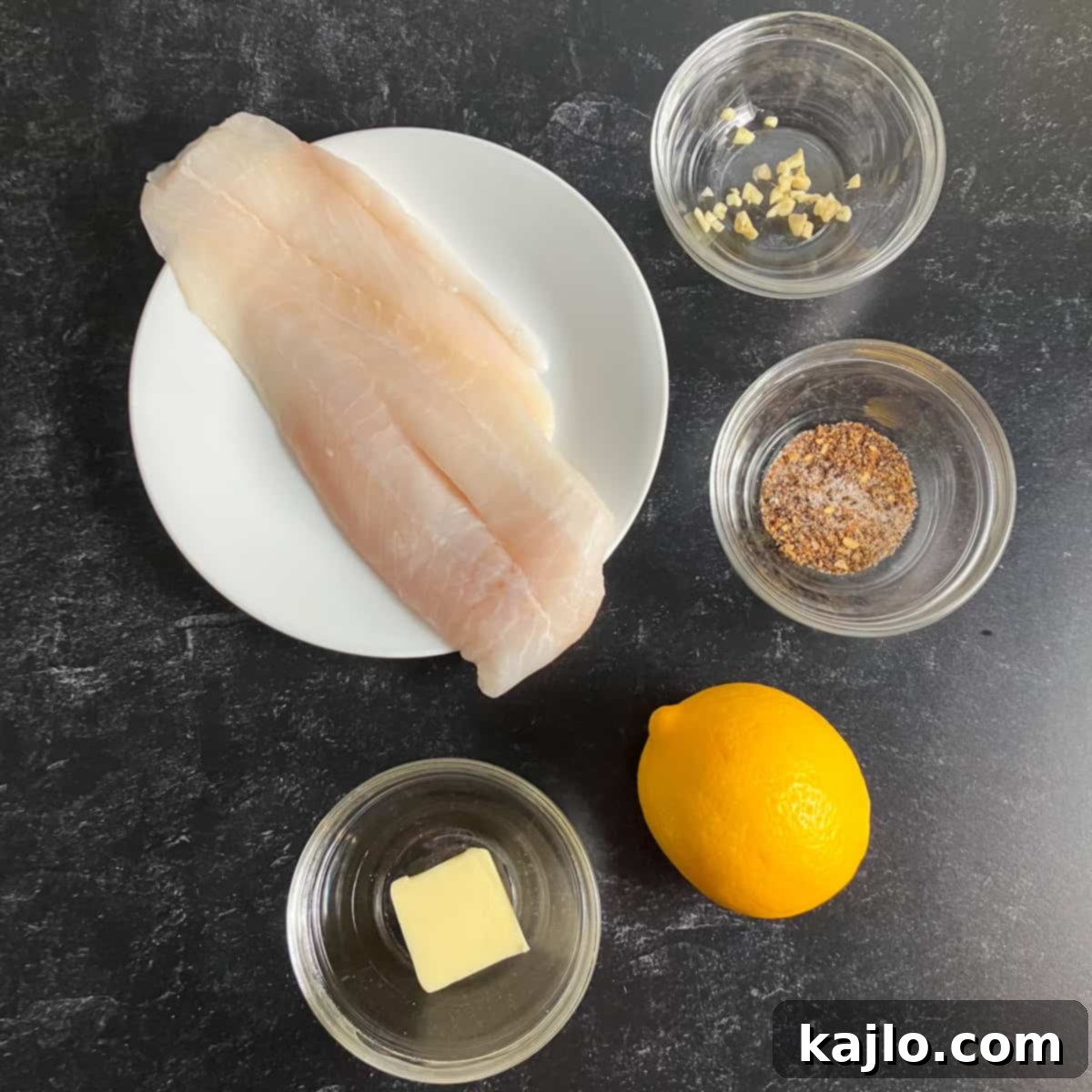
Specific quantities for all ingredients are conveniently located in the detailed recipe card at the very bottom of this article!
When selecting your orange roughy, look for fillets that are consistently about ¼-inch (0.6 cm) thick. This uniform thickness is critical; if the edges are too thin, they will inevitably dry out and become tough before the thicker center of the fish is fully cooked. For equipment, a sturdy cast iron skillet is ideal for pan-frying, a glass baking dish works wonders for oven baking, and a metal baking pan is best suited for broiling. Regardless of your chosen method, always keep an instant-read meat thermometer handy to accurately check the fish for safe doneness, ensuring both safety and perfect texture.
🥨 Creative Ways to Season Your Orange Roughy
The mild flavor of orange roughy makes it an incredibly versatile canvas for a wide array of seasonings. While our featured recipe uses a simple yet effective lemon pepper blend (with added salt if your blend is salt-free), here are several other fantastic ideas to explore, allowing you to customize your fish to your taste:
- Blackened Orange Roughy: Achieve a bold, smoky, and slightly spicy flavor by coating your fillets in a robust Cajun or blackened seasoning mix before cooking.
- Parmesan Crusted Orange Roughy: Create a savory and crispy exterior by pressing a mixture of grated Parmesan cheese and breadcrumbs (or panko for extra crunch) onto the fillets.
- Italian Seasoning: A blend of classic Italian herbs like oregano, basil, thyme, and rosemary provides an aromatic and comforting Mediterranean profile.
- Red Pepper Flakes: For those who enjoy a kick, a sprinkle of red pepper flakes can transform your dish into spicy orange roughy, adding a pleasant heat.
- Garlic Butter: This classic combination is a foolproof winner for seafood. Melted butter infused with plenty of fresh garlic creates an irresistible aroma and taste.
- Onion Powder: Adds a subtle, sweet, and savory depth to the fish without introducing the texture of fresh onion.
- Paprika: Use sweet, smoked, or hot paprika to add color and a nuanced flavor, from mild and earthy to smoky or spicy.
- Dill: A fresh herb with a distinct, slightly tangy flavor that is traditionally paired with whitefish and lemon.
Keep in mind that altering your seasoning or adding a crust (like panko or almondine) can slightly impact the cooking time. For an extra gourmet touch, consider topping your cooked orange roughy with a rich lemon cream sauce, a vibrant keto pesto, or a tangy sweet and sour sauce to elevate the dish further.
🔪 Mastering the Art of Cooking Orange Roughy
In my opinion, the best way to cook orange roughy for both speed and moisture is pan-frying. This method is significantly faster than baking, as it eliminates the need to preheat a large oven. Moreover, I’ve found that pan-frying consistently yields a moister, more tender fillet compared to broiling, which can sometimes lead to slightly drier results if not carefully monitored. Each method, however, has its unique advantages.
🍳 Pan-Fried Orange Roughy Recipe (My Top Pick!)
Achieve perfectly flaky and moist orange roughy with this quick pan-frying method, emphasizing a beautiful sear and tender interior:
Begin by thoroughly patting your orange roughy fillet dry on both sides with paper towels. This crucial step is key to achieving a desirable golden-brown sear. Generously season both sides of the fillet with lemon pepper seasoning. If you’re using a salt-free lemon pepper blend or simply prefer more salt, add a touch to taste at this stage.
In a cast iron skillet, melt one tablespoon of unsalted butter over medium heat. Add one minced clove of fresh garlic to the melted butter and allow it to infuse its aroma for about 30 seconds, being careful not to let the garlic burn. Carefully place the seasoned orange roughy fillet into the hot skillet. Cook for approximately 3 minutes per side, for a total cooking time of 5-6 minutes. The fish should turn opaque and begin to flake.
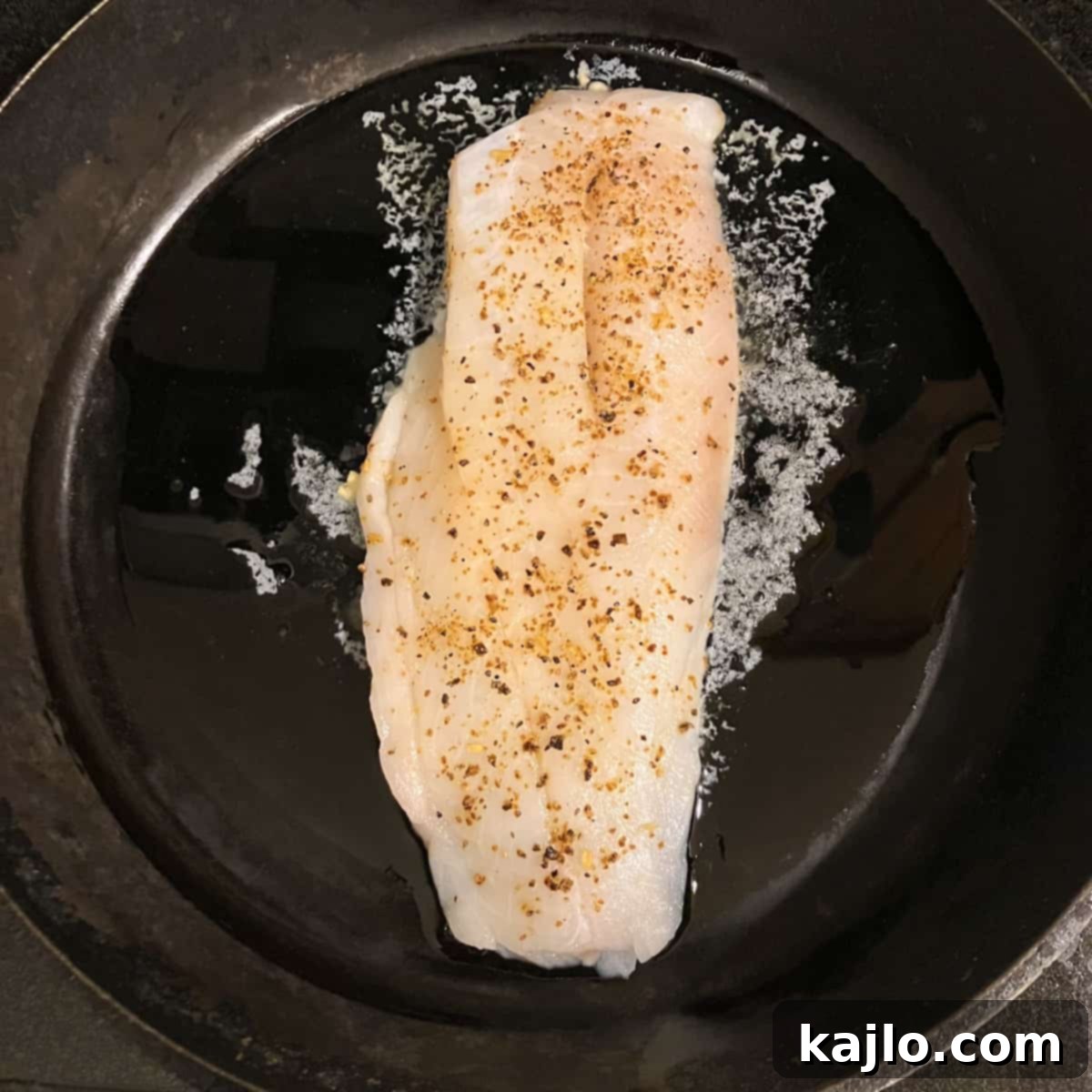
To ensure food safety and perfect doneness, insert an instant-read meat thermometer into the thickest part of the fish fillet. The internal temperature should register 145°F (63°C). If it hasn’t reached this temperature, continue cooking for short additional intervals until it does. Once cooked, serve your pan-fried orange roughy with a fresh squeeze of lemon juice, a delicate sprinkle of lemon zest, and a pinch of finely chopped fresh parsley for an enhanced flavor and elegant presentation.
⌛ Effortless Baked Orange Roughy
Baking provides a convenient, hands-off method for cooking orange roughy, perfect for when you prefer your oven to do the work. You might ask, how long to bake orange roughy? What temperature for orange roughy? For optimal results, you’ll typically bake orange roughy for 6-10 minutes at a steady temperature of 425°F (218°C).
Preheat your oven to 425°F (218°C). Gently pat the orange roughy fillets dry with paper towels to prepare them for seasoning. Season both sides generously with lemon pepper and, if desired, a dash of salt. Place the seasoned fish in an oiled glass baking dish, ensuring the fillets are in a single layer to promote even cooking.
Melt a tablespoon of butter and then stir in one finely chopped clove of garlic. This aromatic butter mixture will add a rich flavor to your fish. Pour the melted garlic butter evenly over the fish fillets in the baking pan. Place the baking dish on a rack positioned approximately one-third down from the top of the oven and bake for 6-10 minutes. Adjust baking time as needed based on your fillets’ thickness and oven calibration.
Once the baking time is complete, always verify the fish’s doneness using a meat thermometer; it should reach a safe internal temperature of 145°F (63°C). The fish should appear opaque and flake easily. Before serving, sprinkle the baked orange roughy with fresh lemon zest, a dash of finely chopped parsley, and a generous squeeze of freshly extracted lemon juice to enhance its vibrant flavors.
🔥 Perfectly Broiled Orange Roughy
Broiling is an excellent method for achieving a delightful, slightly crisp exterior while ensuring the interior of the fish remains moist and tender. This technique cooks quickly under direct, high heat:
To prepare your orange roughy for broiling, start by thoroughly patting the fish fillets dry with paper towels. Season both sides with your preferred seasonings, such as lemon pepper and salt. Lightly spray a small metal baking pan with cooking oil spray to prevent the delicate fish from sticking.
Arrange the seasoned fish fillets in the prepared baking pan and squeeze a generous amount of fresh lemon juice directly over them. Important Note: It is crucial NOT to add the melted butter at this stage. Butter can easily burn or cause dangerous flare-ups under the intense, direct heat of a broiler, posing a significant fire hazard.
Place the baking pan under the broiler and broil the fish on a low setting for approximately 5-6 minutes. Broilers can vary greatly in intensity, so it’s important to monitor the fish closely to prevent overcooking. Use an instant-read thermometer to check the internal temperature of the thickest part of the fillet; it should reach 145°F (63°C). Adjust broiling time as necessary until it’s perfectly cooked.
After the fish is cooked and safely removed from the broiler, immediately drizzle it with melted butter that has been mixed with minced garlic. The residual heat from the fish and the warmth of the butter will gently mellow the fresh garlic flavor, creating a delightful aroma. Finish by sprinkling with fresh lemon zest and finely chopped parsley before serving to add brightness and freshness.

🌡 What is the Safe Internal Temperature for Orange Roughy?
For both food safety and optimal culinary results, orange roughy should be cooked to a minimum safe internal temperature of 145°F (63°C). This can be accurately verified by inserting an instant-read meat thermometer into the thickest part of the fillet. You’ll know orange roughy is fully cooked when it appears opaque throughout its flesh and flakes easily and gently with a fork, indicating a tender and moist texture.
🤔 How to Reheat Cooked Orange Roughy
This recipe is designed for a single serving and is generally best enjoyed immediately after preparation. However, if you have leftovers, cooked orange roughy can be safely stored in a covered container in the refrigerator for up to 1-2 days. To reheat, you have a couple of good options: use an air fryer for a quick refresh that can help restore some crispness, or opt for the microwave for speed and convenience, though the texture might be slightly softer.
🥗 Delectable Sides to Serve with Orange Roughy
Curious about what goes with orange roughy? Its delicate and mild flavor makes it an incredibly versatile fish that pairs beautifully with a wide array of side dishes. My personal go-to combinations are roasted asparagus, which adds a lovely crisp-tender green element, and fluffy wild rice, offering a satisfying and earthy carbohydrate. For a truly indulgent meal, consider transforming it into a “surf and turf” by pairing it with a perfectly cooked air fryer ribeye steak and creamy mashed potatoes.
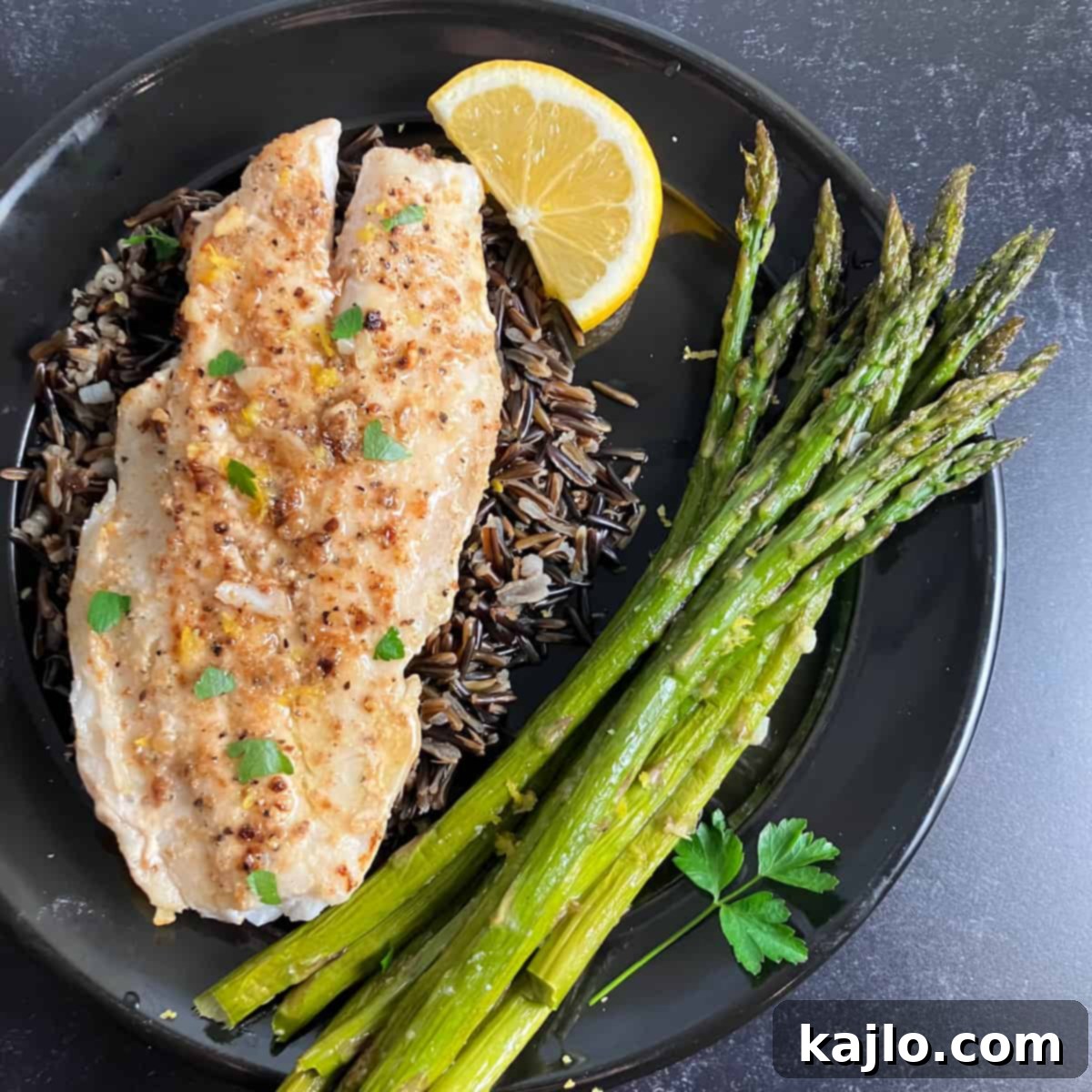
Here are some other fantastic and easy-to-prepare side dishes that complement orange roughy perfectly:
- Peach Pineapple Salsa: A refreshing and vibrant fruity salsa that adds a burst of tropical flavor.
- Kale Apple Slaw: A crisp, healthy, and tangy slaw that provides a wonderful textural contrast.
- Costco Cauliflower Rice: An excellent low-carb alternative to traditional rice, light and absorbent of flavors.
- Frozen Green Beans in Air Fryer: A super quick method to get perfectly tender-crisp green beans.
- Air Fryer Garlic Bread: Warm, buttery, and garlicky bread is always a crowd-pleaser with fish.
- Air Fryer Frozen Vegetables: A convenient way to prepare various frozen vegetables to accompany your fish.
📜 Orange Roughy Nutrition Information (Raw Fillet)
For one standard 4-ounce serving (approximately 113 grams) of plain, raw orange roughy fillet, the estimated nutritional breakdown is as follows:
- Calories: 90 kcal
- Total Fat: 1g
- Saturated Fat: 0g
- Cholesterol: 70mg
- Sodium: 80mg
- Total Carbohydrate: 0g
- Fiber: 0g
- Protein: 18g
- Calcium: 0% Daily Value (DV)
- Iron: 6% Daily Value (DV)
- Potassium: 190mg
Please note: This nutritional information pertains to plain orange roughy without any added butter or seasonings. The comprehensive nutrition information for the full recipe, including all ingredients, is available in the detailed recipe card provided further down this post. These values are estimates and can vary based on specific product brands and preparation methods.
Frequently Asked Questions (FAQs) About Orange Roughy
How to Grill Orange Roughy?
Grilling orange roughy is a fantastic option for imparting a lovely smoky flavor and char. To prepare, season your fillets as desired and lightly brush them with oil to prevent sticking to the grill grates. Grill the orange roughy for approximately 3-5 minutes per side, or until the internal temperature reaches a safe 145°F (63°C). The exact grilling time will largely depend on how hot your grill is and the precise thickness of your fish fillets. Using a grilling basket can be particularly helpful for keeping the delicate fish intact and preventing it from flaking through the grates.
How to Air Fry Orange Roughy?
For a quick, easy, and deliciously crispy air fryer orange roughy recipe, begin by seasoning your fish fillets to taste and brushing them lightly with oil. Place the seasoned fish in a single layer in your air fryer basket, or on the top rack if you are using an air fryer oven. Air fry at 400°F (200°C) for about 5-6 minutes. Always use an instant-read meat thermometer to confirm that the internal temperature of the thickest part of the fish has reached 145°F (63°C) before serving. These timing guidelines are optimal for ¼-inch thick fillets.
How to Cook Orange Roughy from Frozen?
To cook orange roughy directly from its frozen state, a good initial step is to place the frozen fillet in your air fryer at 400°F (200°C) for 2-3 minutes. This brief period helps to partially thaw the fish, making it easier to work with. Once it has thawed slightly, you can then proceed by following the air fryer orange roughy directions mentioned above. Alternatively, for best results and more versatile cooking options, it’s always recommended to thaw the fish completely in the refrigerator overnight before cooking using any method.
What are Good Fish Substitutes for Orange Roughy?
If you are looking for alternatives that offer a similar mild flavor and delicate texture to orange roughy, consider fish varieties such as cod, halibut, flounder, sole, or sea bass. These types of whitefish are often interchangeable in recipes, provided that their fillet weight and thickness are comparable. This ensures that the cooking times and the final texture of your dish will be similar, allowing for easy substitutions.
Where to Buy Orange Roughy?
Orange roughy can sometimes be a bit elusive in standard local grocery stores, partly due to its sustainability concerns. However, larger retail chains, such as Super Walmart, occasionally stock it. For a potentially wider selection and availability, you might also find orange roughy to purchase from online seafood purveyors. You can check options like those found here on Amazon, which often carry a broader range of specialty seafood not always available at brick-and-mortar stores.
👩🏾🍯 More Delicious Fish Recipes to Explore
If you’re eager to expand your culinary repertoire with more fantastic fish preparation ideas, consider trying these other delightful recipes:
- Air Fryer Halibut
- Frozen Salmon in Air Fryer
- Air Fryer Frozen Tilapia
- Frozen Cod in Air Fryer
- How Long to Bake Salmon at 375
Orange Roughy Recipes (Pan-Fried, Baked, or Broiled Fish Fillet)
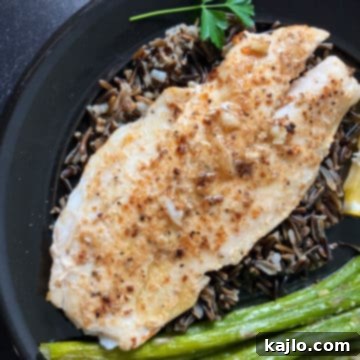
Here are three versatile ways to prepare orange roughy: pan-fried for a quick meal, baked for a hands-off approach, and broiled for a slight crisp! Perfect for a healthy and delicious dinner idea.
Author: Summer Yule
Rating: 5 out of 5 stars (based on 3 votes)
Watch How to Make It!
Prep Time: 4 minutes
Cook Time: 6 minutes
Total Time: 10 minutes
Course: Dinner
Cuisine: American
Servings: 1
Calories: 243 kcal
Ingredients
- 6 ounces (170 grams) orange roughy fillet (skinless, boneless, ¼-inch thick)
- Lemon pepper seasoning (to taste)
- Salt (optional, if using salt-free seasoning or to preference)
- 1 tablespoon unsalted butter
- 1 clove fresh garlic, minced
- Freshly squeezed lemon juice (for serving)
- Lemon zest (for garnish)
- Fresh parsley, finely chopped (optional garnish)
Instructions
Pan-Fried Orange Roughy:
- Pat the fish fillet thoroughly dry with paper towels. Season both sides generously with lemon pepper (and salt, if desired).
- Heat butter in a cast iron skillet over medium heat with the minced garlic for about 30 seconds. Add the seasoned orange roughy fillet. Cook for approximately 3 minutes per side, totaling 5-6 minutes.
- Check the thickest part of the fish with a meat thermometer to ensure it reaches 145°F (63°C). Add more cooking time in short increments if needed.
- Serve the cooked fish immediately with a squeeze of fresh lemon juice and a sprinkle of lemon zest and fresh parsley.
Baked Orange Roughy:
- Preheat your oven to 425°F (218°C). Pat the fish dry with paper towels and season with lemon pepper (and optional salt). Place the fish in an oiled glass baking dish.
- Melt butter and stir in one finely chopped clove of garlic. Pour this butter mixture evenly over the fish in the baking pan. Bake the fish for 6-10 minutes on a rack positioned one-third down from the top of the oven.
- After baking, verify the fish has reached a safe internal temperature of 145°F (63°C). Sprinkle with lemon zest, chopped parsley, and freshly squeezed lemon juice before serving.
Broiled Orange Roughy:
- Pat the fish dry with paper towels and season thoroughly on both sides. Lightly spray a small metal baking pan with cooking spray.
- Place the seasoned fish in the baking pan and squeeze fresh lemon juice on top. Important: Do NOT add the melted butter at this stage, as it can burn under the broiler’s high heat and cause flare-ups.
- Broil the fish on a low setting for 5-6 minutes, monitoring closely. Check the temperature of the thickest part of the fish (it should be 145°F / 63°C), and add additional broiling time as needed.
- After cooking, remove from broiler and drizzle with the melted butter and minced garlic. The residual heat will gently mellow the garlic. Sprinkle with lemon zest and fresh parsley, then enjoy.
Recommended Equipment
- Cast Iron Skillet (ideal for pan-frying)
- Spatula (for handling delicate fish)
- Kitchen Thermometer (instant-read for accuracy)
- Glass Baking Dish (for oven baking)
- Metal Baking Pan (for broiling)
Notes from Dietitian Summer Yule
This recipe is considered a “Level 2” recipe, suitable for individuals in transition or weight maintenance phases. To significantly reduce the calorie count of this low-calorie orange roughy recipe, you can opt to broil the fish and skip the final butter drizzle, which will save you approximately 100 calories per serving.
As a white fish, orange roughy is an inherently lean protein, naturally low in fat. While this is beneficial for those monitoring fat intake, it also means it contains lower levels of beneficial Omega-3 fatty acids (EPA and DHA) compared to fattier fish varieties. If Omega-3s are a priority, consider complementing this dish with other sources or choosing fattier fish more often.
Why might orange roughy be considered “bad” for you?
The primary nutritional reason to limit your intake of orange roughy is its high mercury content. Unfortunately, it falls into the category of fish with elevated mercury levels, similar to swordfish, shark, tilefish, and king mackerel. For this reason, I advise consuming it only occasionally. Moreover, pregnant women, breastfeeding women, and young children should completely avoid orange roughy and other high-mercury fish due to potential health risks.
The other significant concern revolves around its sustainability. The Monterey Bay Aquarium Seafood Watch List explicitly recommends avoiding orange roughy due to its slow reproductive cycle and vulnerability to overfishing. If you are committed to choosing seafood with a lower environmental impact, it is best to opt for more sustainable fish species.
Please remember that nutrition information provided is for one serving of the complete recipe as specified.
Nutrition Information (Per Serving – Full Recipe)
Based on the recipe, one serving (as prepared) contains approximately:
- Calories: 243 kcal
- Carbohydrates: 2g
- Protein: 28.7g
- Fat: 12.6g
- Saturated Fat: 7g
- Vitamin A: 11% DV
- Vitamin C: 11.4% DV
- Iron: 9.4% DV
This information is an estimate and may vary slightly depending on the specific brands and quantities of ingredients used.
Keywords
Baked Orange Roughy, Broiled Orange Roughy, Orange Roughy, Orange Roughy Baked, Orange Roughy Broiled, Orange Roughy Pan Fried, Orange Roughy Recipe, Oven Baked Orange Roughy, Pan Fried Orange Roughy, Recipe for Orange Roughy
⭐ Love this recipe? Please consider leaving a comment below and sharing your experience!
Nutrition Info Disclaimer
All recipes on this website may or may not be appropriate for you, depending on your medical needs and personal preferences. Consult with a registered dietitian or your physician if you need help determining the dietary pattern that may be best for you.
The nutrition information is an estimate provided as a courtesy. It will differ depending on the specific brands and ingredients that you use. Calorie information on food labels may be inaccurate, so please don’t sweat the numbers too much.
“To taste” means to your preferences, which may have to be visual to follow food safety rules. Please don’t eat undercooked food.
Join our community! Subscribe for all of the latest and greatest recipes, and follow me on Facebook, Pinterest, Instagram, and YouTube!
